Les Contes d’Hoffmann (Jacques Offenbach)
Scénographie, costumes Philippos Vazakas
Quand on lit l’Homme au Sable (d’où est tirée l’histoire d’Olympia) ou le Conseiller Crespel (qui donnera naissance à l’acte d’Antonia) d’E.T.A. Hoffmann, on est frappé par le fait que l’on ne sait pas très bien si tout ce qui arrive est le fruit de l’imagination du héros ou se passe dans la réalité. C’est, je crois, ce qui en fait la force et c’est cette vision que nous retenons aujourd’hui.
Dans l’opéra, Hoffmann mais aussi Crespel voient dans le Docteur Miracle le diable en personne (et c’est peut-être le fin mot de l’histoire) mais l’impact sera plus fort si, plutôt que de surligner ses traits, on le représente sous un aspect anodin, presque débonnaire. « Ai-je bien vu ? Ai-je bien entendu ? Ne suis-je pas le jouet d’un rêve ? » Laisser planer un doute qui entretiendra l’imaginaire de l’interprète, du spectateur, voici l’univers auquel nous voulons donner vie.
LES PERSONNAGES
A la lecture du chef d’œuvre d’Offenbach nous apparaît un Hoffmann avant tout poète, musicien, voyageur à la poursuite d’une quête dont il ignore lui-même le sens, c’est pourquoi son costume traduit le fait qu’il est un étudiant ayant peu de moyen mais faisant attention à son allure. Au prologue et à l’épilogue, ses habits sont cependant en partie salis par toutes les lieues parcourues. Chez Spalanzanni il est impeccable, un peu moins déjà chez Antonia, etc… Commençant ses aventures en chemise, on le vêtira d’un gilet puis d’une veste, enfin d’un manteau pour illustrer le froid grandissant qui l’entoure, les véritables épreuves successives dans lesquelles il s’engouffre. Eternel amoureux qui pourra dire au soir de sa vie : « il m’est arrivé les histoires les plus étranges ».
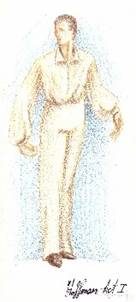
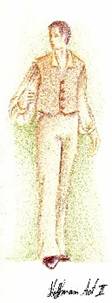
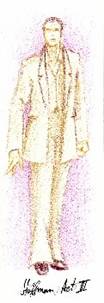
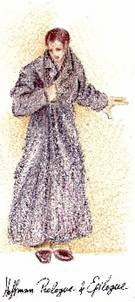
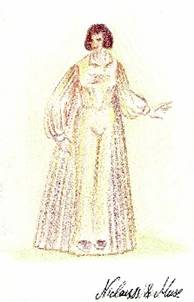
Il est un autre axe né celui-ci d’une vision plus personnelle. Il concerne le personnage de Nicklausse alias La Muse. Il m’importe d’en faire un rôle dense et fondamental dans l’ouvrage (on choisira donc pour elle une scène -récit et air- soulignant ce rôle particulier). Son sens de la répartie en fait un personnage clé sur le plan dramatique. Son regard spirituel plein d’ironie a la fonction d’intermédiaire entre le monde réel et l’imagination enflammée du poète. Elle sera le véritable amour d’Hoffmann, celui qui lui « correspondait » mais qu’il n’a jamais vu comme on ne regarde pas (ou plus) les êtres qui sont trop proches de nous. Elle ne l’abandonne jamais dans ses aventures, trop liée à lui pour le juger, toujours présente au bon moment pour le sauver et sachant même s’effacer quand la situation l’exige. Qu’est ce qui lui est demandé ! Mais c’est une grande âme, une grande dame sous ses aspects de confidente. Cela ne l’empêchera pas de camoufler des gestes de jalousie ou de désespoir mais elle est celle qui restera jusqu’au bout. Et là elle viendra sauver in extremis un Hoffmann hébété, épuisé, ivre, au bord du précipice de la folie et du néant. Il ouvrira enfin les yeux mais on découvrira avec une infinie tristesse qu’après tout ce temps écoulé, elle aura vieilli : il est toujours jeune car prisonnier de l’enchantement, elle est restée en dehors. Il a donc fallu à Hoffmann de nombreuses années pour se frayer un chemin vers elle à travers ses chimères.
Vu ce qui a été dit concernant les quatre rôles tenus par le baryton-basse, ce dernier n’aura qu’un costume. Seule sa coiffure passera de laquée pour Lindorf à échevelée pour Coppélius puis négligée concernant le Docteur Miracle, enfin naturelle chez Dapertutto.
Si possible (on connaît les difficultés que cela soulève) les rôles d’Olympia, Antonia et Giuletta seront tenus par la même chanteuse (ou trois personnalités assez proches physiquement et vocalement) qui sera d’abord automate, convalescente aux membres inférieurs encore bien faibles puis femme fatale au corps et aux gestes envoûtants.
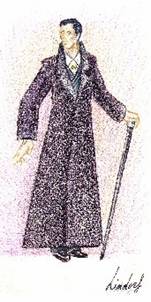
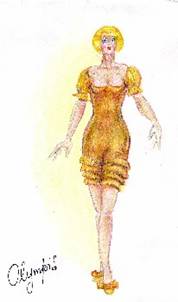
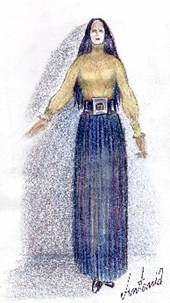
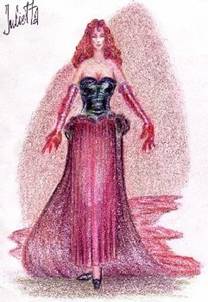
Le rôle secondaire de ténor ( Andrès, Cochenille, Frantz et Pitichinaccio) devra avoir une belle voix de lyrique, lyrique-léger et posséder un bon sens théâtral permettant un comique plus subtil qu’à l’accoutumée. Il est le contre-poids nécessaire à la respiration des scènes.
Enfin le personnage de Stella ne sera qu’une allusion (ou une « illusion » de plus ?), une allégorie du divin Mozart qu’elle chante quelque part dans un autre monde. On parle d’elle, on l’attend mais elle ne viendra jamais.
LE DECOR
Il oppose la géométrie pure du cercle a des éléments plus baroques (la harpe, le clavecin, « le meuble à violons », les tentures, le sofa et les lustres) comme si l’histoire se passait dans un vaisseau spatial naviguant vers une destination inconnue qui est peut-être le monde du rêve, ramenant à son bord des vestiges du passé. C’est la mise en parallèle de ces deux composantes (le passé et l’avenir) qui donne à nos yeux la force nécessaire au décor de telles mésaventures.
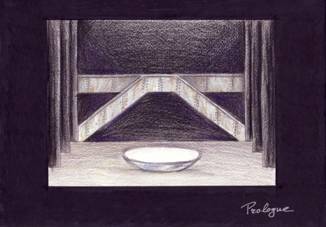
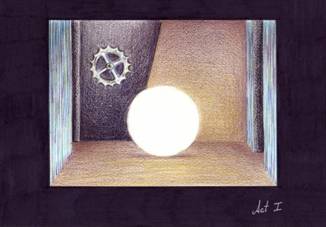

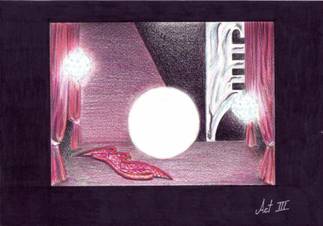
Le cercle magique : tout va naître d’un cercle symbolisant la fantasmagorie, tour à tour maléfique et bénéfique, conque originelle portant la Muse, de dessous lequel surgissent les esprits, lieu de la vision d’Hoffmann, table des étudiants, ring autour duquel a lieu la joute littéraire qui oppose Hoffmann et Lindorf, écrin d’Olympia, écran de projection de l’œil, du diamant en trois dimensions, toile sur laquelle une ombre se projette, une scène se reflète et à travers laquelle on devine la mère d’Antonia, lune blême ou soleil sanglant, astre ou vaisseau emportant Hoffmann et Nicklausse. C’est de lui que naît cette quasi légende. Pendant tout l’opéra, il est le cercle infernal dont on ne peut sortir. A l’extrême fin il est le lieu de métamorphose : c’est en lui que vient le salut d’Hoffmann grâce à Nicklausse.
STORY BOARD
PRELUDE Curtain
PROLOGUE
First bars of the introduction, curtain-raiser: the Muse is lying on the central structure, the spirits (dancers moving like frogs, spiders, monkeys) come out of a trap in front of it and invade the stage. At her wave they disperse in the wings. In a short monologue, she shows her irony and her feelings towards Hoffmann (H.), dropping a robe she transforms herself in Nicklausse (Ni.) then goes out back left.
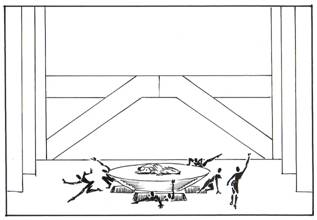

Andrès comes in with a lantern, afraid of Lindorf’s entrance forward right (where Le Conseiller will sing his aria). Luther and barmen (dancers) arrive with a barrel, glasses and stools from the back. Exuberant students enter by the stairs from which H. followed by Ni. will come a little bit after. Central part of Kleinzach’s song: H. is standing on the structure. “Allumons le punch” : all lean over the structure lighted blue and gold, Lindorf and H. oppose themselves turning around this kind of “ring”. Then the chorus puts it up right and secures it. At the pleasure of hearing stories, smoke of the pipes rises up. H. passes his hand in front of the circle. Black out: the circle alone remains illuminated on stage, everybody goes out, the stairs are removed. Back wall for Olympia’s act takes place at the right always during the black out.
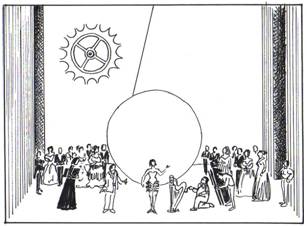
ACT 1
During the fugato’s part of the MENUET, Spalanzzani (S.) enters with a draughtscreen. He puts it in front of the circle. A turning cogwheel comes down slowly from the top back left. “Là, dors en paix”: this SCENE is singing to underline S.’s madness. Hoffmann appears, then Cochenille (Ce.). H. alone: “elle est là, si j’osais”: but he cannot look behind the screen and goes to the public to sing his ROMANCE front stage. “Par Dieu, j’étais bien sûr”: Nicklausse comes in full of irony. Coppélius (Cs.) enters on his theme (this theme is heard for the first time, not with Lindorf at the prologue). He asks to Ce. to bring his large catalogue (with barometers…) and shows it to H. : “Voyez ces baromètres”. CHANSON : “J’ai des yeux”, Cs. takes out of his pocket a little box, opening it two eyes appear that seem to observe H. terrified. But Cs. has made a mistake: here is the good one with spectacles! H. puts them on and could see the creature while S. and Cs. agree hypocritically. Guests magically come in. “Silence, la voici” : Ce. takes the screen away in left wings (Olympia takes advantage to hide behind) but S. makes him unterstand to bring it back. « Je vous présente ma fille » : Ce. folds the screen and carries it away under his arm. Olympia (O.) appears still. At S.’s sign, she begins to move imperceptibly. Chorus takes place around the music-hall show. Ce. brings the mechanical harp to S. who starts to play. CHANSON D’OLYMPIA “Les oiseaux dans la charmille”: at her first hesitation (she falls asleep) Ce. coughs to wake up O.. At the second time, he gives her discreetly a nudge. “Le souper vous attend” : chorus goes out in any direction. During his aria H. is more and more passionate with the result that he releases the mechanism at the beginning of the next scene. O. starts to turn on the stage until to go out right, H. following her. Full of rage, Cs. appears on the left, staying in the darkness on the side of the stage. FINAL: chorus enters dancing the waltz. S. confides O. to H. In front of the circle, their whirling goes progressively as quickly as possible. “Qu’on les arrête” : chorus is afraid, N. cannot stop them. S. must intervene. H. faints. « Reconduis-la »: Ce. and O. go out slowly. H. recovers consciousness but remains lying on the floor. Ce. suddenly shouts : in the darkness, at the limit of the right wings, an arm is getting up, pouncing upon the doll and crushing it. At this very moment someone of the chorus destroys H.’s spectacles fallen on the floor. S. rushes. Cs. and him face with inside anger. Cruelly sarcastic and scoffer, chorus encircles progressively H. A silent eye which seems to observe the public and resumes the act, appears in the circle. Curtain.
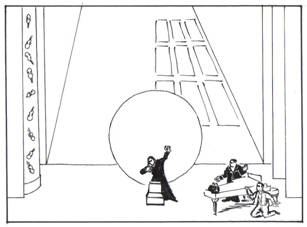
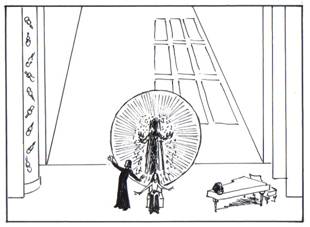
ACT 2
ENTR’ACT: Curtain on the harp’s arpeggio.
ROMANCE: Antonia (A.) is sitting at the cembalo then turning away goes to the window (open on nothingness). Beginning of the aria: she turns over and draws near the keyboard. « Chère fleur » : she sits again, standing up on : « Que ton coeur vienne à moi ». End of her aria: head in her arms on the instrument. Crespel (Cr.) enters left. They exchange a few words while just the mother’s theme is played. She goes out. Speaking scene between Cr. and Frantz (F.). Happy to be finally alone F. sings for himself transforming his rag in a kilt. Hoffmann followed by Nicklausse have a few words with him. H. alone sits at the cembalo. DUO: A. comes behind him. He stands up quickly. « Viens là comme autrefois »:They sit together.« C’est une chanson d’amour » :They walk. Singing scene : hearing her father, she runs away. H. hides at the left of the cembalo. Cr. and F. enter. « Loin de moi qu’on le chasse »: Cr. the head in his hands but Miracle (M.) comes out the circle with a small suitcase. After « Je ne veux pas vous déplaire »: M. has a gesture of concentration. « Que fais-tu, traître »: Cr. falls on the seat. TRIO: Bar 5: at a movement of M. a chair rises from the stage in front of the circle. “Laissez-moi l’interroger”: M. closing his eyes, his left arm in the direction of Antonia’s room from where a light comes to us. “Qui? moi?”: Cr. stands up suddenly then, afraid, goes to left. “Tais-toi, tais-toi” : he rushes on M. who pushes back him to right. “J’ai là certains flacons”: M. opens his bag. “Eh! Oui, je vous entends”: he walks to the A.’s door. Cr. intervenes, first he moves back but finally succeeds to put outside M. who brandishes his bottles (long version M. reenters and after the trio Cr. goes out with him). Singing scene between H. and A. ”Je ne chanterai plus”: she falls on the chair without realize. TRIO: Only her face is lightened. M. at first hided appears slowly behind her head like a double of her thought. “Quelles amours sont donc les vôtres” : M. folded arms, standing. « Le temps de l’infidèlité » : he disappears. At the invocation of A.’s mother, he’s behind the circle. “Que tu veux abdiquer » : The mother (could be a figurant), clouded over, comes from back stage (going up a slope) and appears bit by bit in the circle. « Non! Assez ! Je succombe » : M. is in front of the circle. « Je cède au transport qui m’enivre » : he commands the violins in their glass case which is progressively bursting into light followed by extinction. Then the circle burns from the outside to the center until it’s totally consumed just after the end of the trio (projection). A. falls on her kneels, holding out an imploring hand to the circle. M. goes on the chair which sinks with him. FINAL: Cr. dashes, takes his daughter in his arms where she dies. H. rushes in. Cr. shouts at him always holding his daughter, he asks for a knife to kill H. At this very moment M. appears holding obviously the knife but N. enters and M. hides it. He gives his medical opinion about the A.’s death with great indifference: “Morte”. Curtain.
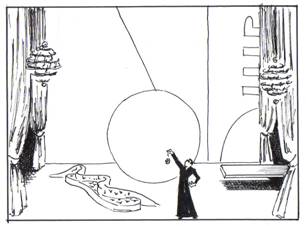
ACT 3
ENTR’ACT ET BARCAROLLE Curtain raises slowly. Hoffmann with Nicklausse at his right and Giuletta (G.) at his left is in the middle of phantomatics guests who are wallowed on the sofa and on the floor, partly undressed after an orgy. Pittichinaccio (P.) is here too. N. and G. sing to H. and to the public with their different feelings the celebrate words: “belle nuit, ô nuit d’amour, souris à nos ivresses… le temps fuit et sans retour emporte nos tendresses”. Velvet curtains, sofa, G.’s dress and hair: all that envelopes Hoffmann in a snare and a delusion where he is caught like a prisoner. Softness illustrates the aquatic element of this scene. The circle looks like an old silvered mirror (behind a tulle’s curtain). The image that it reflects is very woolly.“ Et moi, ce n’est pas là pardieu ce qui m’enchante”: H. waking up of his drunkenness stands up progressively on the sofa. He begins to sing the COUPLETS BACHIQUES, soon rejoined by the chorus. Schlemil (S.) enters: speaking SCENE. “Holà! Calmez-vous” : beginning of the music evoking the poet and musician and relaxing the atmosphere. “Et venez prendre place au Pharaon”: G. invites everybody to play. A long endless table comes out mysteriously from right. Guests surround it. H. will follow them but N. stops him by his arm: “Un mot, j’ai deux chevaux sellés”. “Allons, allons”: they rejoign the players. Dapertutto (D.) enters discreetly on left, looking in their direction. AIR “Scintille diamant”, he takes out of his coat a black velvet purse from which he extracts slowly a chain. At the end of it, there is a big diamond of an incomparable beauty that he makes sparkle. He draws the precious stone up in front of the circle which is illuminated, transmitting the strange light to all the space of the room. All the women are progressively hypnotized. Men take them out right. H. can’t persuade G. to follow him. She stays alone in front of D., attracted “à distance” ( remember Miracle) by the hypnotical gem. D. asks her the H.’s reflection. To obtain this he makes her easily full of jealousy. « C’est lui, c’est lui » : H. comes back putting on his coat. « Vous me quittez ? ». DUO : G. wants to save him in appearance but she ‘s no more than an instrument in D.’s hands. Final of the duo : after « Ton reflet, donne-le moi, mon coeur l’attend de toi » go directly to « Aujourd’hui, aujourd’hui les larmes » unisono. They fall on the sofa kissing each other. SCENE DU REFLET: S. enters running followed by D., P., N. and then by the guests. « Comme vous êtes pâle » : D., G. and H. between them at precise places are in front of the circle. We see only the D.’s and G.’s reflections (between the tulle and the mirror, a piece of fabric slides hindering the H.’s reflection). « J’ai perdu mon reflet » : H. facing the circle. then he turns over, taking his hands to his face, he makes a few steps on right in reeling. SEPTUOR (septet with chorus) : chorus a little backward occupying all the stage, nobody moves during all this piece. At the last word: “Hélas”, guests with falling shoulders turn aside their’s head and go out back left and right. FINAL: “Ecoutez”, messieurs” : G. moves back right, facing the public. An early morning faint mist rises from the ground. ”Vous n’avez pas d’épée, prenez la mienne”: H. and S. fight. The shadow: when H. is in front of the circle, his shadow is seen, S. no (they’re never together in front of the circle). S. is killed, he falls on the table which returns in wings, carrying away his body. (If S. who has lost his shadow dies, what will happen to H. who has no more reflection?) H. and N. must run away. The circle loses its mirror’s aspect and becomes a sorrowful pale moon. Some guards are looking for the fugitives with torches. The stage’s getting black progressively.
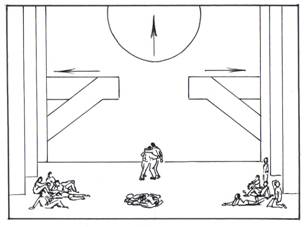
EPILOGUE
In this version the INTERMEZZO isn’t played. ENTR’ACT: curtain-raiser. It’s the dawn. H., N., Lu. and students are sitting or lying relaxed. ”Je te brise comme ceci”: H. breaks his glass on the floor. « Ah! Je suis fou » : all look at the pieces of the glass seeming to shine strangely. « Le néant par qui l’on oublie » : H. takes a handful of them, observe them, then let them fall again slowly. They sing the CHOEUR as if it was just a remembrance (or: we just hear from top and wings H. and chorus recorded). Men fall asleep. Only H. and N. are still awake. H. is lying on the floor. N. leans over him, full of compassion. She looks a little older. At last she tells him the truth. “O Dieu de quelle ivresse embrases-tu mon âme” : H. emerges of his visions, he draws himself up. She helps him to stand up. « Muse aimée, je suis à toi ». We don’t know if these words are for N. She takes off his overcoat and lets it fall down. At the same time the circle begins to go up as an opening in the sky and stairs move to left and right. H. leans on N.’s shoulders. They leave slowly the stage in the early morning’s light under the circle. Students wake up as they’ve had this vision of a rising circle. Standing up, they move forward and sing as it was a walking song with a great feeling of liberty in the fresh wind of a new day.